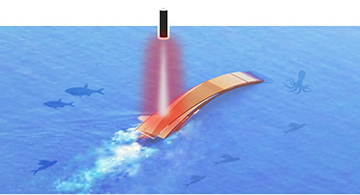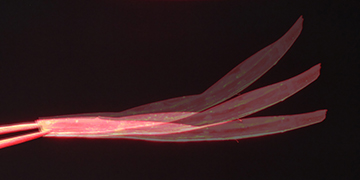
Artist’s conception of a Neusbot—a tiny, soft, light-powered robot built by a team at the University of California, Riverside, USA—on the open ocean with a secondary light source. [Image: Zhiwei Li, UC Riverside]
Fossil-fueled steam engines once powered locomotives, ships and the factories of the Industrial Revolution. Now a tiny, “soft” robot that converts light into steam power can paddle around on the surface of water and adapt its motion to the available illumination (Sci. Robotics, doi: 10.1126/scirobotics.abi4523).
The soft robot consists of a reusable hydrogel film containing metallic nanorods that convert incident light into heat, which in turn turns the water inside the gel to steam-filled bubbles. The bubbles cause the gel structure to oscillate and propel itself on the water’s surface, like a tiny paddle. The scientists who developed the biomimetic oscillator hope it will someday be able to absorb spilled oil or other contaminants in water.
Inspired by insects
Many researchers have tried to make adaptive robots out of soft materials rather than the rigid metal or plastic frames and skeletons of conventional moving devices. Most of these soft oscillators, though, require external power inputs, or they sluggishly respond to internal power from heat or chemical reactions.
In the current study, the scientists, led by chemist Zhiwei Li of the University of California, Riverside, got the idea for their gel robots from neustons—a category of animals such as the water strider, an insect adapted to walk on water with support from surface tension.
The miniature robots built by Li’s team contain a porous polymer hydrogel infused with iron oxide and copper nanorods. Together, these materials experience surface plasmonic resonances that quickly convert white light to heat. Li and his colleagues sandwiched this hydrogel between two other hydrophobic polymeric materials with different thermal-expansion coefficients.
Bubbling up

Superimposed images showing the Neusbot’s bending process. [Image: Zhiwei Li, UC Riverside]
The hydrogel absorbs water, while the layers above and below it resist water and allow the device to float. Under irradiation, the nanorods heat up, and water inside the device—which Li’s group dubbed the “Neusbot,” after neustons—turns into bubbles of steam. The bubbles perturb the film out of its equilibrium position, setting up a regular oscillation. As the water vapor escapes from the hydrogel, it absorbs more liquid water, which is again converted to steam.
Under illumination from low-intensity near-infrared lasers, the Neusbots, a few millimeters long, propelled themselves at a rate of about four “body lengths” per minute. The researchers found that they could control the direction of the Neusbots by controlling the duration of laser irradiation.
According to a press release accompanying the research, the team hopes to test an upgraded version that includes a fourth layer that can absorb oil or other chemicals. The group envisions that—either simply following the track of the sun, or controlled via an additional light source—the Neusbots could cruise along the surface of polluted water, sucking up the oil or chemicals “like a robot vacuum,” according to Li.
Other scientists involved in this study were Nosang Vincent Myung of the University of Notre Dame and Yadong Yin of UC Riverside.

